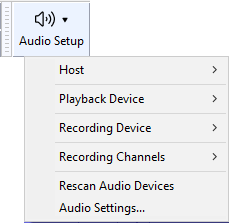
On Windows, sound devices often lack a "Stereo Mix" or similar input, or it must be specially enabled in the Windows "Sound" Control Panel.
| You can also choose Windows WASAPI host and the (loopback) input choice in Audio Setup Toolbar. This will record computer playback even if the computer sound device lacks its own input to do this. |
Click on the Audio Setup button in the the top tooldock and click on Audio Settings . For details please see Audio Setup Toolbar.

This selects the particular interface with which Audacity communicates with your chosen recording and playback devices.

If you do not see Stereo Mix or similar:
You must play the audio you want to record using the same sound device that has the "Stereo Mix" or similar input. You cannot play audio through an HDMI output or through a headset, headphones or speakers that connect via USB or wirelessly then record that playback using the stereo mix input of the built-in sound device.
Choose the Windows WASAPI host (next section) if you want to record playback of a USB, wireless or external sound device.
| This is the recommended method of recording audio playing on the computer on Windows with Audacity. |
On Windows, you can choose the Windows WASAPI Audio Host and then the (loopback) input in the Recording Device box. Choose the loopback input for the computer playback device you will be listening to (for example, "Speakers (loopback)". The loopback input records computer playback even if your sound device lacks its own stereo mix or similar input.

WASAPI loopback has a big advantage over stereo mix or similar inputs provided by the audio interface. The capture is entirely digital (rather than converting to analog for playback, then back to digital when Audacity receives it).
| Windows WASAPI host only records loopback when there is an active signal present. When there is no active signal, recording pauses and will restart once an active signal resumes. |
The behavior of the Audacity playback and recording sliders may vary according to the sound device you are recording from.
| If you do not see any input for recording computer playback, exit Audacity and continue reading below. |
Windows, computers almost always only have microphone inputs enabled by default. Earlier Windows systems may also need the input for recording computer playback to be made visible before Audacity can use it. To show or enable inputs, launch the sound device control panel from the Windows Control Panel or from the system tray (by the clock).
For a more detailed walk-through of the above steps for Windows (or if that does not work for your version of Windows), see Windows: accessing the Windows Sound controls.
If you still have no stereo mix input in Windows, sometimes this input can be enabled in the audio interface's own control panel, especially with older RealTek devices. The audio interface's own control panel can be found in the Windows Control Panel.
Hints for RealTek control panels:
If there is still no suitable input, try updating the sound device drivers for your audio interface. This can sometimes produce an additional input for recording computer playback, and may fix other problems such as poor quality or skipping.
An alternative method of recording audio playing on the computer is to buy a cable with 1/8 inch (3.5 mm) stereo connectors at each end. Suitable cables are available from almost any audio retailer. Connect one end of the cable to the computer's audio output (green) and the other end to the line-in input (blue). Then choose the line-in as input device in Audacity.
| Connecting to the microphone input (red) may produce mono sound or poor quality. |
To hear what is playing while you record it, buy a single stereo to double stereo adaptor to plug into the audio output. This gives you a spare jack to plug the speakers or headphones into.
You can use other applications to record computer playback that do not rely on the computer sound device having this ability. These applications will make an audio file which can then be imported into Audacity for editing.
All the options below grab the audio digitally from the application producing the sound. This has advantages over stereo mix recording. Lossy digital-analog-digital conversions are avoided and also unwanted system beeps and alerts are not captured.
A further alternative is an external USB audio interface with a "Stereo Mix" type of option.
Not all USB audio interfaces offer a Stereo Mix option, so read the specifications carefully before purchasing.